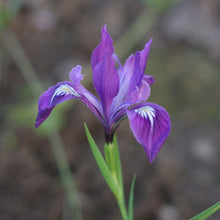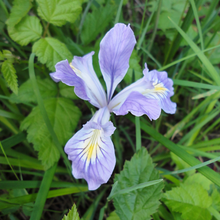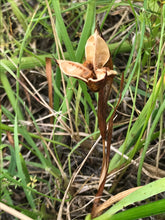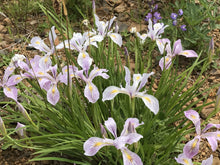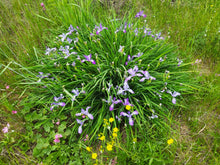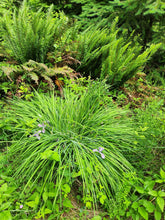
Iris tenax
Oregon Iris, aka tough-leaved iris, is a show-stopper. When mature, it grows into low mounds of hardy, lance-shaped foliage which eventually flaunt many stalks of extraordinary and long-lasting blooms in late spring and early summer. The flowers are typically lavender-blue to purple, but in rare and special cases they can bloom white, yellow, pink, and even orchid-shades. Oregon iris rhizomes spread slowly, so it has the appearance of a tight bunchgrass when not in bloom. Due to this slower growth rate, it may behoove you to splurge on a larger size to enjoy its lavish blooms sooner.
- Plant type/canopy layer: deciduous, perennial, herbaceous plant
- Size at maturity: 10-20" tall, 12-24” wide
- Light requirements: full sun, part sun/part shade
- Moisture requirements: dry to moist soil, prefers well-drained
- Bloom time: March - July (April - June in the Portland Metro area)
- Growth rate/ease: medium growth rate, moderately easy to grow
- Wildlife support: flowers attract and provides nectar for hummingbirds, adult butterflies, bees and other insect pollinators; overall plant attracts and supports beneficial and other pest-eating insects
- Native habitat/range: can be found growing along roadsides, in meadows and forest opening in west-side forest openings, at low to middle elevations, across the western Oregon, northwestern California and south-western Washington. Portland Plant List - yes.
- Special features & uses: supports hummingbirds; deer resistant; drought-tolerant once established; exceptionally strong fibers leaves can be used for weaving and rope making; landscape uses include meadowscapes, pollinator gardens, rock gardens, raingardens or bioswales
Gardening with Oregon Iris: Oregon Iris prefers sandy or loamy soils that are dry to moist and well-drained. It can tolerate drought once established, but will not do well in clay. It works well along the top edges of sunny raingardens and bioswales but will die if it has its feet wet for prolonged periods of time. It grows relatively slowly by rhizomes, eventually forming small clumps. Although it can tolerate shade, you will not enjoy the plethora of blooms it can produce when planted in more sun. That said, even the smallest pops of its bold purple petals can be a sight to behold in a shady woodland garden.
Photo Credit 1: Karli Del Biondo, Beetles and Bees
Photo Credit 2: "Oregon Iris (Fen Meadow)" by catalex7 is licensed under CC BY 2.0
Photo Credit 3: © Aaron Liston, some rights reserved (CC-BY)
Photo Credit 4: © rappman, some rights reserved (CC-BY)
Photo Credit 5: © Arcticwish, some rights reserved (CC-BY)
Photo Credit 6: © Jeffrey Lee (he/him/his), some rights reserved (CC-BY)
Photo Credit 7: © Sam Kieschnick, some rights reserved (CC-BY)







